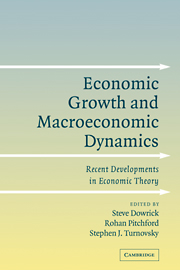Book contents
- Frontmatter
- Contents
- Preface
- Contributors
- PART ONE TOPICS IN GROWTH THEORY
- PART TWO STATISTICAL ISSUES IN GROWTH AND DYNAMICS
- PART THREE DYNAMIC ISSUES IN INTERNATIONAL ECONOMICS
- 6 Dynamic Trade Creation
- 7 Substitutability of Capital, Investment Costs, and Foreign Aid
- 8 Microchurning with Smooth Macro Growth: Two Examples
- Index
7 - Substitutability of Capital, Investment Costs, and Foreign Aid
Published online by Cambridge University Press: 31 October 2009
- Frontmatter
- Contents
- Preface
- Contributors
- PART ONE TOPICS IN GROWTH THEORY
- PART TWO STATISTICAL ISSUES IN GROWTH AND DYNAMICS
- PART THREE DYNAMIC ISSUES IN INTERNATIONAL ECONOMICS
- 6 Dynamic Trade Creation
- 7 Substitutability of Capital, Investment Costs, and Foreign Aid
- 8 Microchurning with Smooth Macro Growth: Two Examples
- Index
Summary
INTRODUCTION
Public investment is widely accepted as being a crucial determinant of economic growth. Interest in the impact of public capital on private capital accumulation and economic growth originated with the seminal theoretical work of Arrow andKurz (1970) and the more recent empirical research of Aschauer (1989a, 1989b). Most of the subsequent literature has focused on closed economies, using both the Ramsey model and the AK endogenous growth framework (see, e.g., Futagami et al., 1993; Glomm and Ravikumar, 1994; Baxter and King, 1993; Fisher and Turnovsky, 1998). Turnovsky (1997a) extends Futagami et al.'s work to a small open economy and introduces various forms of distortionary taxation, as well as the possibility of both external and internal debt financing. Devarajan et al. (1998) address the issue of whether public capital should be provided through taxation or through granting subsidies to private providers.
A critical issue, especially in poor, resource-constrained developing countries, concerns how the new investment in infrastructure is financed. One significant source for funding such investment is external financing. This may be in the form of borrowing from abroad, through bilateral or multilateral loans, or through unilateral capital transfers, in the form of tied grants or official development assistance, as recently observed in the European Union (EU). Faced with below-average per capita incomes and low growth rates among some of its joining members, the EU introduced pre-accession aid programs to assist these and other potential member nations in their transition into the union. This process of “catching up” began in 1989 with a program of unilateral capital transfers from the EU through the Structural Funds program, and subsequent programs were introduced in 1993 and in 2000.
- Type
- Chapter
- Information
- Economic Growth and Macroeconomic DynamicsRecent Developments in Economic Theory, pp. 138 - 170Publisher: Cambridge University PressPrint publication year: 2004
- 8
- Cited by



